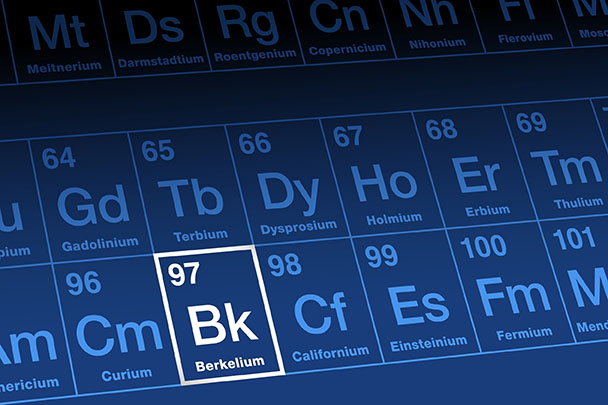
< Back
berkelium
Definition
Berkelium is a chemical element with the symbol Bk and atomic number 97. It is a synthetic element, meaning that it is not found naturally in the Earth's crust. Berkelium was first created in 1949 by the American chemist Glenn T. Seaborg and his colleagues at the University of California, Berkeley.
Berkelium is a silvery-white metal that is radioactive. It has a half-life of about 330 years, which means that it takes 330 years for half of the berkelium atoms in a sample to decay. Berkelium is a member of the actinide series, which is a group of elements that are all radioactive.
Berkelium has no known practical applications. It is too rare and too radioactive to be used in any commercial products. However, berkelium is a valuable research tool for scientists who study nuclear physics and chemistry.
How can the word be used?
The first sample of berkelium was created in a particle accelerator at the University of California, Berkeley.

Different forms of the word
Noun:
berkelium (a synthetic, radioactive metallic element with the symbol Bk and atomic number 97).
Adjective:
berkelium (of or relating to berkelium).
Etymology
The word "berkelium" is named after the city of Berkeley, California, where it was first created in 1949. The element was discovered by a team of scientists led by Glenn Seaborg at the University of California, Berkeley.
Question
What does berkelium look like?
AQA Science Exam Question and Answer
Question:
Define the chemical element "berkelium," including its symbol, atomic number, and key properties. Describe its significance and applications in scientific research.
Answer:
Berkelium is a chemical element with the symbol Bk and atomic number 97. It is a member of the actinide series in the Periodic Table.
Berkelium is a highly radioactive element, and its most stable isotope has a relatively short half-life. Due to its radioactivity and scarcity, berkelium is challenging to isolate and study in significant quantities. As a result, it has limited practical applications outside of scientific research.
In scientific research, berkelium is primarily used for studies in nuclear physics and nuclear chemistry. Scientists use berkelium isotopes to investigate the behaviour of heavy, unstable elements and to understand the processes of nuclear fission and radioactive decay. Additionally, berkelium has been used in the synthesis of other transuranium elements, furthering our understanding of the structure and properties of heavy elements. Its unique properties and role in nuclear research contribute to advancing our knowledge of fundamental atomic and nuclear processes.